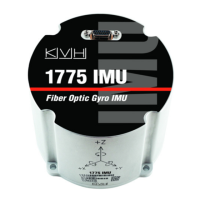This document contains proprietary information of KVH Industries, Inc. and neither this document nor said proprietary information shall be
published, reproduced, copied, disclosed, or used for any purpose without the express written permission of a duly authorized KVH representative.
Page 47 of 77
8.26 =msync
8.26.1 Description
This command configures the system’s data output request method for Normal Mode. It can be
set to use an internally generated periodic clock in IMU mode, or to use the external interface
MSYNC signal in EXT mode. (See Section 10.3 for important information regarding the use of
the Master Synchronization Input.) This command is related to the =DR and =OUTPUTFMT
commands and define the Normal Mode behavior.
8.26.2 Usage
=MSYNC,<EXT|IMU>
IMU mode generates the Normal Mode data output messages based on the data rate defined
by the =DR command. EXT mode uses the Master Synchronization Input signal on the
interface connector to request data output at a user-driven rate. The user-driven output rate
can be either periodic or aperiodic. Setting this to EXT will automatically engage the Uniform
Averager type output filtering on both the accelerometer and gyro data (see the =FILTTYPE
command). It will not change the filter enable configuration however.
8.26.3 Response
MSYNC,<EXT|IMU>
8.27 ?msync
8.27.1 Description
This command queries whether the system is expecting timing synchronization via the Master
Synchronization Input or if it internally controls the output timing. (See Section 10.3 for details
about the Master Synchronization Input.)
8.27.2 Usage
?MSYNC
8.27.3 Response
MSYNC,<EXT|IMU>
8.28 =outputfmt
8.28.1 Description
This command configures the output format of the binary data message used in the Normal
Mode. The value is stored in non-volatile memory.
8.28.2 Usage
=OUTPUTFMT,<A|B|C>
8.28.3 Response
OUTPUTFMT,<A|B|C>

